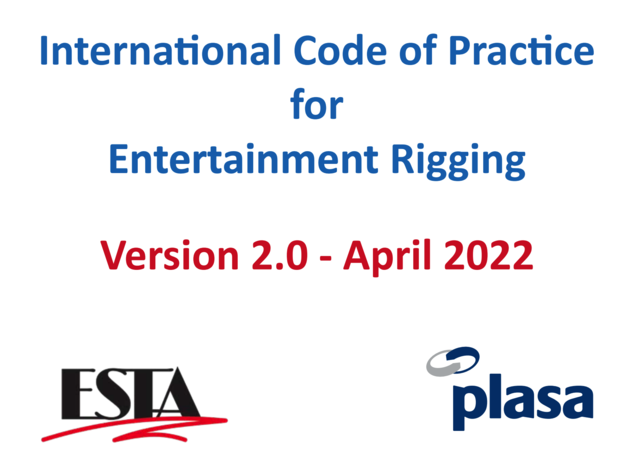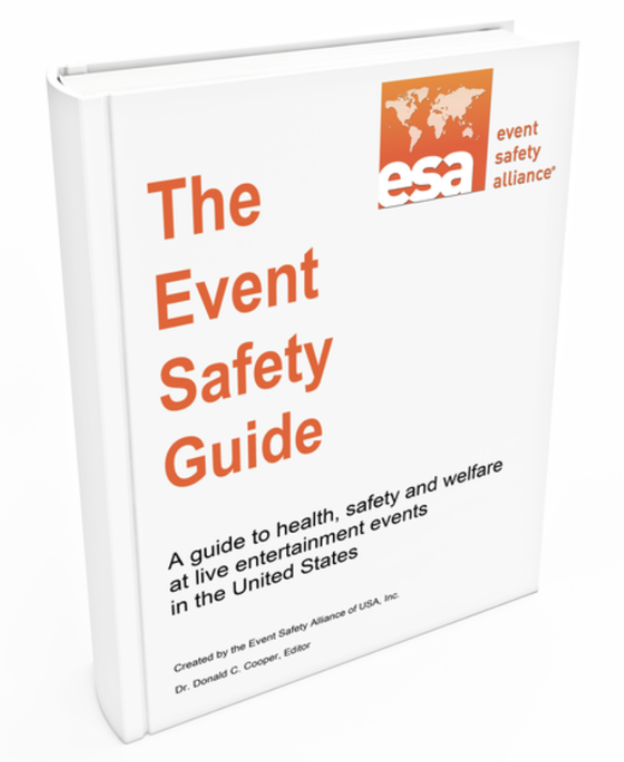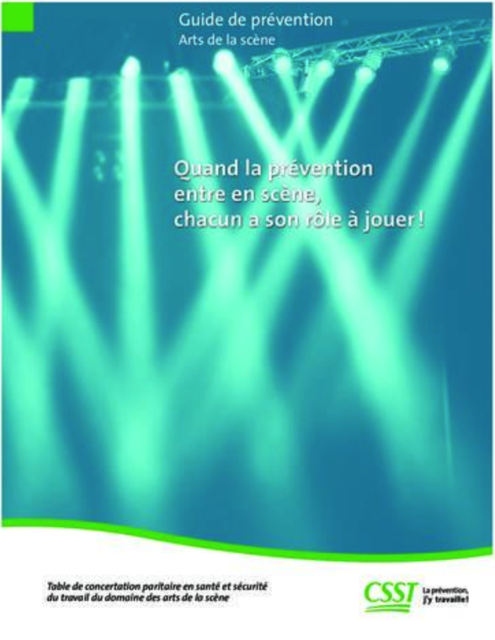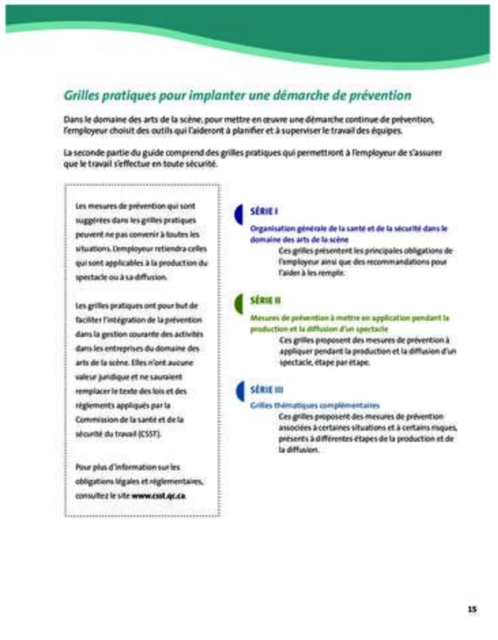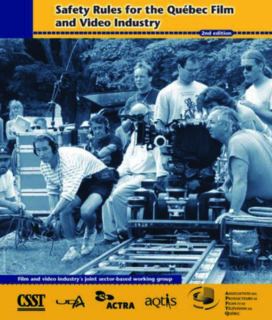Best Practices Guidelines
Live performance venues and production shops can be dangerous places to work in. They contain a vast assortment of equipment, tools, chemicals, and people, which together create the play, musical, dance, or opera. Those same components can also create numerous hazards, some with the potential of causing permanent personal injury. Hazard recognition, assessment and control are key to reducing and eliminating real and potential hazards. Everything we do has potential hazards, and everyone we work with is a partner in hazard recognition or a potential victim in occurrences.*
Over the past years, many provincial organisations have created health and safety guidelines and best practices manuals to help us avoid many occurrences and reduce the damage and injury from occurrences that do occur on stage and backstage. Below is a list of those publications, which most are available free of charge. We invite you to download them and use them wisely.
* Text Source: Safety Guidelines for the Live Performance Industry in Ontario
|
|
INTERNATIONALInternational Code of Practice for Entertainment Rigging 2.0 The purpose of the International Code of Practice for Entertainment Rigging is to promote awareness and safety worldwide by providing a model code of practice with a focus on arena rigging. The practices described in the code are intended to provide a universal foundation for those engaged in planning, managing and executing rigging. ICOPER also provides guidelines for those who wish to develop policy, design training content or help establish certification criteria. Recognition and acceptance of this universal code will help promote regulatory harmony and reduce potential conflicts between regions around the world. The resulting improvements in communications and relations with regional and local regulators will be particularly beneficial to those professionals involved in international production. Learn more and download the Code here: https://esta.org/ESTA/icoper.php THE EVENT SAFETY GUIDE The premier safety guidebook for anyone working in the event industry. The Event Safety Guide is the United States’ first published safety guidance directed specifically at the live event industry. Culled from existing life safety standards and the insight of top professionals within the event industry, The Event Safety Guide compiles the best operational practices currently available in the live event industry in a single easily referenced manual. The guide is not a “how-to book” or a complicated set of standards. Rather, it is intended to help busy industry professionals know what safe workplace practices might be, heighten their understanding of the importance of safety in everything they do, and apply these best practices in their daily work. The Event Safety Guide is now available as a free PDF download. With just a few clicks, you can access a world of field-proven guidance and operational best practices wherever you go. You can get your copy here: https://www.eventsafetyalliance.org/the-event-safety-guide ESTA TECHNICAL STANDARDS PROGRAM The ESTA Technical Standards Program is the only ANSI-accredited standards program dedicated to the needs of the entertainment technology industry. The standards created under the TSP are used directly or indirectly every day by almost every manufacturer, dealer, installer, production company and end user. These standards prevent accidents, protect lives and property, save time and money, solve problems, inform the industry, and enhance creativity. The TSP is comprised of over 350 volunteer experts who devote time and knowledge to drafting American National Standards for the benefit of the whole entertainment technology industry. Learn more here: https://tsp.esta.org/tsp/index.html Download a copy of the latest American National Standards, developed by the Event Safety Working Group through ESTA's Technical Standards Program. Download links: |
 |
BRITISH COLUMBIAACTSAFE SAFETY ASSOCIATION Actsafe is dedicated to the promotion of health and safety in British Columbia’s motion picture and performing arts industries. Our role is to provide arts workers and employers with the necessary support to ensure everyone goes home safely at the end of the day. Actsafe's resources can be used Canada-wide to help implement or supplement a production’s health and safety program. They include a wide selection of tools, documents and recommendations to help employers develop production-specific programs. |
ALBERTASAFE STAGES Safe Stages is a joint initiative of Theatre Alberta and Alberta Employment, Immigration and Industry (Workplace Innovation and Continuous Improvement Branch) and consist of an occupational health and safety resource (190-page binder) for the Alberta theatre community with best practices, forms and additional resources. A guide to Alberta’s occupational health and safety legislation for employers and workers in the theatre industry — it contains information applicable to all theatre companies, managers, technicians, artists and volunteers in the industry — from the largest of professional and amateur theatre companies and venues, to the smallest of independent productions and found spaces where theatre is produced. Please visit their website for more information and to download Safe Stages. |
|
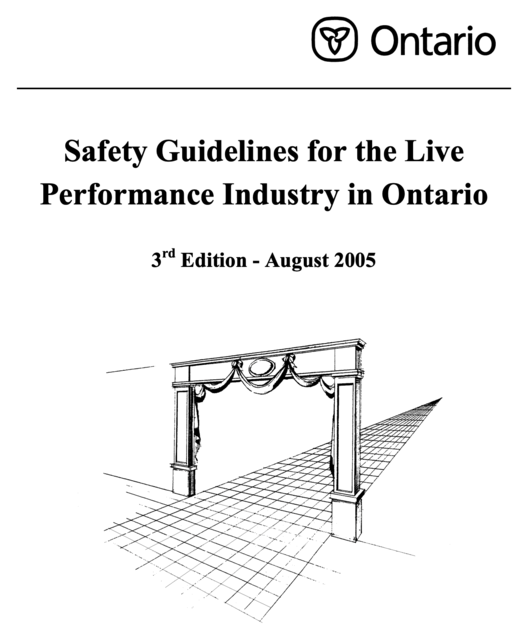 |
ONTARIOSAFETY GUIDELINES FOR THE LIVE PERFORMANCE INDUSTRY IN ONTARIO The Safety Guidelines for the Live Performance Industry in Ontario (the Guidelines) grew out of a need to address health and safety problems that are unique to our business. The Occupational Health and Safety Act (the Act) is the primary source for the issues and information in this document. Each employer/engager, supervisor and working professional (“worker”) needs to be familiar with the provisions of the Act and the regulations that apply to live performance work environments. All of these workplace parties have responsibilities under the Act and the regulations. It is important to note that the Act considers all self-employed independent contractors to be "workers". In the context of live performance workplaces, inspectors with the Ministry of Labour will apply the requirements of the Occupational Health and Safety Act and the relevant regulations made under the Act such as Regulations for Industrial Establishments, Workplace Hazardous Materials Information System (WHMIS) Regulation, and Regulations for Construction Projects. Ministry inspectors will also be made aware of these Guidelines, but it is important to remember that their responsibility is to apply and enforce the law and they are not bound by or obliged to apply the Guidelines. Visit this website for more information and the most up-to-date Guidelines: https://www.ontario.ca/document/safety-guidelines-live-performance-industry |
|
|
QUÉBEC
|


